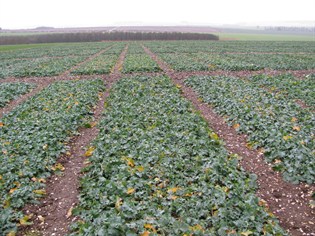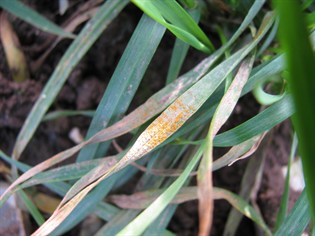In early to mid January 2012, winter barley tiller numbers at Haywold and Horningsea are largely similar to those seen in January 2010 and 2011.
In contrast, tiller numbers in wheat plots at Haywold and Cammeringham are higher this year compared to the previous two seasons.However, the dry start and continuing dry conditions at Horningsea have meant canopies there are smaller.
Over the last month, there seems to have been a subtle change in tiller numbers in the trials
with a trend of similar or lower tiller numbers in the winter barley plots yet generally higher tiller numbers in the wheat plots. Where tiller numbers are higher, careful canopy management will be required in the spring.
Tiller numbers at Frontier trials sites 2010 -2012:
|
SITE |
WINTER BARLEY |
WINTER WHEAT |
||||
|
2012 |
2011 |
2010 |
2012 |
2011 |
2010 |
|
|
HAYWOLD (sowing date) |
4-5 tillers (16.9.11) |
4-5 tillers (16.9.10) |
5 tillers (9.9.09) |
4-6 tillers (23.9.11) |
2 tillers (26.9.10) |
2 tillers (17.9.09) |
|
HORNINGSEA (sowing date) |
3-4 tillers (14.9.11) |
5 tillers (17.9.10) |
3 tillers (15.9.09) |
2 tillers (23.9.11) |
3 tillers (23.9.10) |
2 tillers (23.9.09) |
|
CAMMERINGHAM (sowing date) |
NA |
NA |
NA |
2-4 tillers (24.9.11) |
2 tillers (22.9.10) |
2 tillers (15.9.09) |
Winter oilseed rape
 The oldest leaves of plants have died back at all sites but canopies still appear 'thick'. There is still potential for significantly cold weather so we intend to review plans for top dressings at the end of January/early February.
The oldest leaves of plants have died back at all sites but canopies still appear 'thick'. There is still potential for significantly cold weather so we intend to review plans for top dressings at the end of January/early February.
Overall disease levels are low.
To date, there are no signs of pigeons landing in the trials at Haywold and Cammeringham.
Plots continue to be monitored and deterrents will be erected as necessary if activity
starts within the plots.
Winter cereal disease levels
 In winter wheat trials, Septoria tritici and mildew are the main foliar diseases at all three
In winter wheat trials, Septoria tritici and mildew are the main foliar diseases at all three
trials centres. Yellow rust has recently appeared in Oakley at Haywold. Brown rust is present
in Oakley at Cammeringham and Horningsea.
In winter barley trials, net blotch and discoloured mildew is present at both Haywold
and Horningsea.
With the current high disease inoculum levels, depending on weather conditions over the next few weeks, the potential for high background disease pressure this spring seems likely.
Wheat bulb fly egg hatch
Egg hatch typically starts following a cold spell, when soil temperatures warm up again to
around 4 ° C. However, egg hatch may then be interrupted if soil temperatures fall,
only to recommence when soil temperatures start to rise.
It has been reported that egg hatch was underway in early January around Cambridge but in
contrast, egg hatch has not yet occurred in the north.
Growers are advised to monitor local temperatures and the web page www.dowagro.com/uk/cereal/pest for further information.
Wheat bulb fly can also have a devastating effect on spring barley crops when larval hatch coincides with seedling emergence and growth. The use of seed treatments containing fludioxynil and tefluthrin can be effective in limiting damage from wheat bulb fly.
Gout fly
No symptoms of gout fly larval have been recorded at any of our sites although there are reports of damaged tillers in some farm crops. In some previous seasons, damage symptoms have typically been observed in early February. The maggots feed on the young plant during the winter and the attacked tillers become swollen and 'gouty'.
While each maggot attacks only one tiller, that tiller will not produce an ear. Where plants are small and backward with few tillers, an early application of nitrogen may be considered to help ensure healthy tillers survive. Chemical control is generally not worthwhile in spring, especially in well-tillered crops.
Spring trials
Frontier is conducting spring barley variety and agronomy trials at Haywold and Horningsea
this spring. In addition, spring bean variety and phosphite trials are being conducted at
Horningsea.
At Horningsea, glyphosate was applied last autumn to 'clean up' any weeds and volunteer cereals ahead of this. A similar application is planned for Haywold.
Whilst every effort has been made to ensure that the information presented in this update is correct, Frontier Agriculture does not accept liability for any error or omission in the content. You are advised to take professional advice when making technical cropping decisions. Contact Frontier today to arrange a visit from one of our local agronomists.









